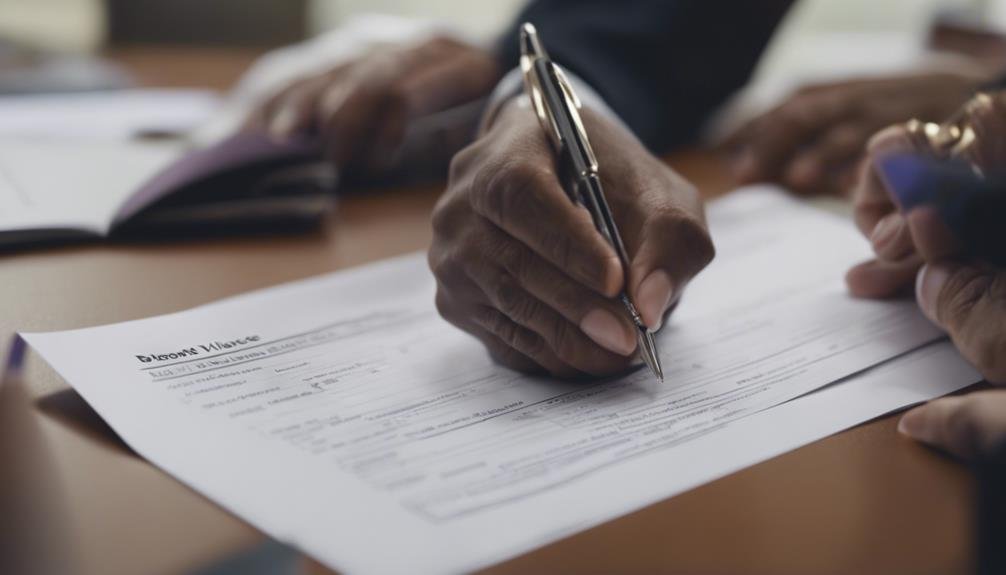Prioritize safety before reporting by contacting authorities and seeking support. Document the incident with details, evidence, and medical records. Seek medical attention promptly, keeping thorough records for legal purposes. Contact the National Domestic Violence Hotline for guidance and support at any time. Pursue legal options such as protection orders for safety and protection. These five steps provide a solid foundation for legally reporting domestic violence and taking necessary actions to ensure your well-being and rights are protected.
Key Takeaways
- Secure safety before reporting to authorities.
- Document incident details and gather evidence.
- Seek medical attention and keep records.
- Contact the Domestic Violence Hotline for guidance.
- Pursue legal options, including obtaining a protection order.
Ensure Safety and Contact Authorities
Securing your safety and promptly contacting authorities are essential initial steps when reporting domestic violence incidents. Domestic violence situations can escalate quickly, so finding a secure location before making a report is indispensable for your safety.
Contacting authorities through emergency hotlines, police departments, or trusted advocates ensures a swift response to the violence you’re experiencing. When reaching out, be prepared to provide key information such as the date, time, location, and details about the perpetrator. Sharing your contact information is necessary for follow-up investigations.
Seek support from victim services units or domestic violence services to receive the assistance needed during the reporting process. These services can connect you with legal advocates who can offer guidance on your legal rights and help navigate the complexities of reporting domestic violence incidents.
Document Incident and Obtain Evidence
Properly documenting the incident and collecting evidence is a critical step in legally reporting domestic violence.
When documenting the abuse within the family, make sure to gather written details, witness statements, and any threatening messages received. This documentation can be pivotal in supporting legal reporting and applications for protection orders.
Additionally, obtaining evidence like medical records, police reports, and any physical evidence of the abuse can greatly strengthen the case. Law enforcement officials rely on this evidence to understand the severity of the situation and take appropriate action to ensure the safety of all involved parties.
Seek Medical Attention and Keep Records
Seeking medical attention promptly after experiencing domestic violence is essential for addressing injuries and documenting evidence effectively. Medical professionals play an important role in documenting injuries, providing medical records, and offering testimony to support legal claims.
Keeping detailed records of medical visits, treatments, and injuries can greatly strengthen legal cases against perpetrators of domestic violence. These records serve as key evidence in obtaining protection orders and seeking justice for domestic violence incidents.
Documenting injuries and medical treatment isn’t only important for immediate medical care but also for establishing a pattern of abuse that can support legal actions against abusers. By maintaining thorough records of medical attention received, individuals can present a detailed account of the harm suffered, enhancing the chances of holding the perpetrator accountable in a court of law.
Medical professionals are valuable allies in this process, offering both documentation and expert testimony to bolster legal claims of domestic violence.
Contact Domestic Violence Hotline for Guidance
Utilizing the National Domestic Violence Hotline for guidance is vital when managing domestic violence situations. The hotline, reachable at 800-799-SAFE (7233), provides essential support through crisis intervention, safety planning, and referrals.
If you prefer texting, simply send ‘START’ to 88788, or access immediate assistance through online chat at thehotline.org. Trained advocates stand ready 24/7 to offer confidential help and resources tailored to your needs.
Whether it’s creating a safety plan, understanding legal options, or connecting with local services, the hotline is equipped to assist you. By reaching out to the National Domestic Violence Hotline, you can access a wealth of guidance and support to navigate through challenging circumstances.
Pursue Legal Options and Protection Order

After contacting the National Domestic Violence Hotline for guidance, the next step involves pursuing legal options and obtaining a protection order to guarantee your safety and seek recourse against the abuser.
Protection orders, issued by the court system, serve to stop harassment and require substantial evidence of abuse to be granted. It’s important to report domestic violence incidents to the authorities promptly to secure legal protection and support.
Violations of protection orders are taken seriously and enforced criminally, highlighting the substantial legal consequences for the abuser. Seeking legal assistance in understanding the process of obtaining a protection order can greatly enhance safety measures for survivors of domestic violence.
Frequently Asked Questions
What Are the Laws on Domestic Violence in Texas?
In Texas, domestic violence laws protect individuals from harm within familial or household relationships. Legal actions can lead to protective orders, support from victim advocacy, and access to counseling resources for safety planning and evidence collection.
What Are the Guiding Principles for Working With Cases Involving Domestic Violence?
In cases involving domestic violence, prioritize victim support, legal options, counseling resources, safety planning, law enforcement involvement, court processes, evidence collection, protective orders, child custody matters, and utilization of community resources for a thorough and survivor-centered approach.
How Do You Deal With Abuse Cases?
Ensuring safety is top priority with abuse cases. Seek counseling support, learn about legal options like protective orders, utilize emergency shelters, report through proper channels, and focus on trauma recovery. Support networks, child custody, and financial aid are essential.
Conclusion
To sum up, remember to take the necessary steps to report domestic violence legally and safely. By following these guidelines, you can protect yourself and seek justice against your abuser.
Remember, the early bird catches the worm – don’t delay in seeking help and taking action. Trust in the system to support you and know that you aren’t alone in this journey towards safety and healing.







